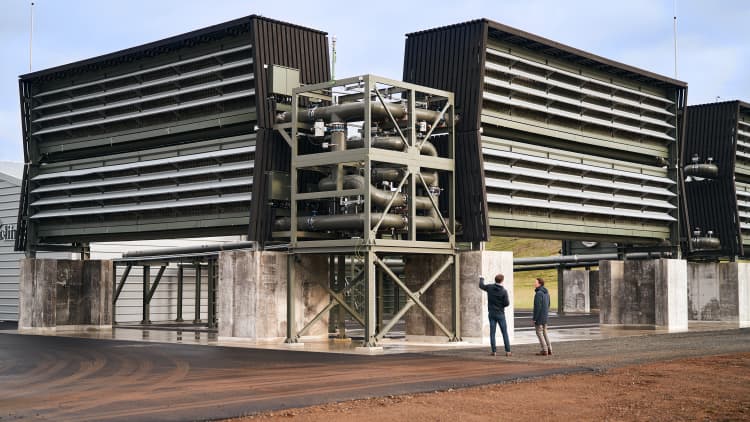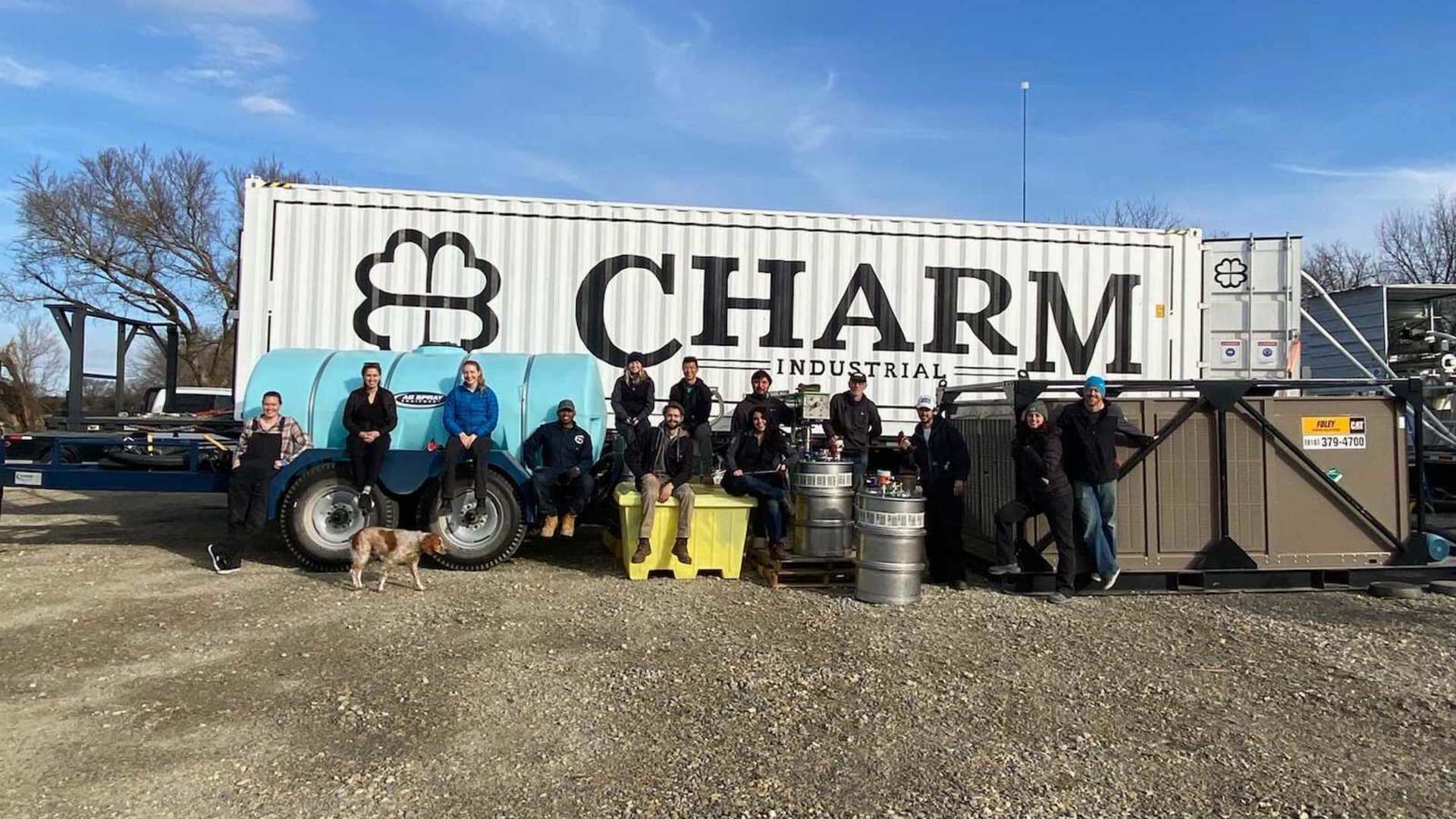The Charm Industrial team.
Photo courtesy Charm Industrial.
The public benefit company Frontier, which has secured more than $1 billion in commitments from its member companies to remove carbon dioxide from the atmosphere, announced on Thursday its first deal with a carbon removal company: Charm Industrial.
Charm will remove 112,000 tons of carbon dioxide between 2024 and 2030 for a payment of $53 million on behalf of Frontier member companies: Alphabet, Autodesk, McKinsey Sustainability, Meta, H&M Group, Shopify, and Workday. In addition to the Frontier member companies, Aledade, Boom Supersonic, Canva, SKIMS, Wise, and Zendesk have committed to buy carbon removal with Frontier via a partnership with Watershed, a carbon accounting firm.
To do this, Charm will convert excess organic material — like corn stover, which is the stalks, leaves and cobs that remain in fields after the corn harvest, and which would otherwise decay and release carbon dioxide into the air — into a bio-oil and then put that oil into the ground in abandoned oil wells.
Before Thursday’s announcement, Frontier, which is owned by payment processor Stripe, had spent $5.6 million buying nearly 9,000 tons of contracted carbon removal from early stage carbon removal startups that are pursuing a handful of techniques. That money has gone to startups via pre-purchase agreements, which are relatively small-scale checks often $500,000, and which are delivered upfront, not conditional on delivery, in an effort to catalyze growth in the industry which is itself still very nascent.
The $53 million contract with Charm is different because it is exponentially larger than previous agreements, and because it’s the first offtake agreement Frontier has inked, which is a legally binding contract paid out as the tons of carbon removal are delivered and sequestered. The 112,000 tons of carbon dioxide that Charm will remove is more than ten times the total quantity of carbon dioxide that has been removed so far with human techniques. It has already removed 6,160 tons.
Frontier picked Charm as its first large-scale carbon removal company because of Charm’s ability to deliver results.
“The field over the past couple of years has grown pretty quickly and is getting a lot of attention, but ultimately, carbon removal really still is in its infancy,” Nan Ransohoff, the head of Frontier, told CNBC. “Charm went from went from concept to delivering thousands of tons in effectively less than three years. I hope that we see many more carbon removal companies with this trajectory.”
While Charm’s progress is a positive step, it’s all still a metaphorical drop in the bucket. In 2022, carbon dioxide emissions related to generating energy were north of 36.8 gigatons (one gigaton is equal to a billion tons), according to a March report from the International Energy Agency. Limiting warming to 1.5 degrees Celsius, the target established by the Paris Climate Agreement, will require removing 6 gigatons of carbon dioxide per year by 2050, according to a 2022 McKinsey report, siting the UN Intergovernmental Panel on Climate Change.
The Charm Industrial setup working in Kansas.
Photo courtesy Charm Industrial.
A frustrated customer and an accidental discovery
Charm CEO Peter Reinhardt, got interested in carbon removal technology first as a frustrated customer.
Reinhardt dropped out of the aerospace engineering program at Massachusetts Institute of Technology in 2011 to start Segment, a customer data platform. He grew the company to over 600 people and several hundred million in revenue before selling it to Twilio for $3.2 billion.
Around 2015, Reinhardt started looking to offset Segment’s emissions.
“Originally, my motivation was to do the right thing for the environment and be able to represent that to employees and customers that we were being responsible about our power consumption and emissions,” Reinhardt told CNBC.
He bought forestry offsets protecting the rainforests in Indonesia and the Amazon, but the more he looked into the money he was spending, the less convinced he became that the offsets were doing much of anything to permanently sequester carbon emissions.
“Why doesn’t the acreage next door just get logged down? How does it actually prevent net acreage getting logged? That’s not clear,” Reinhardt told CNBC.
Verifying permanence was also a problem. “It sounds nice to set aside forest, or even replant forest, but when you get down to the brass tacks of how you actually can be confident that that carbon is going to stay out of the atmosphere, it stops working,” Reinhardt said.
Around 2018, Reinhardt started talking with friends about how to permanently sequester CO2.
A Charm Industrial pyrolyzer apparatus.
Photo courtesy Charm Industrial.
Meanwhile, Charm co-founder and chief scientist, Shaun Meehan, had discovered a carbon sequestration technique almost by accident. Meehan was trying to use biological waste as a fuel for industrial processes like iron-making, and had converted the waste into bio-oil through quick heating. When the plan fell through, Meehan had to get rid of the bio-oil, and one solution he found was to put it into a deep geological well.
Then, Meehan realized dumping bio-oil into a deep well would permanently sequester all the carbon in the organic material that went into making the bio-oil, so it would never seep into the atmosphere as CO2.
“It’s sort of a brilliant, but accidental, discovery,” Reinhardt told CNBC.
In less than a year, within 10 months, Charm completed its first carbon removal injection.
In May 2020, Stripe purchased purchased 416 tons of carbon removal from Charm — its first customer. Charm delivered that carbon removal in April 2021, a year before the Frontier collective launched in April 2022 with $925 million in advanced market commitments.
Pumping ‘barbecue sauce’ into old oil and gas wells
Pumping bio-oil underground can seem like a weird business.
“It’s a little it’s a little odd or unusual, but uniquely American, in that we’re basically pumping barbecue sauce into old oil and gas wells,” Reinhardt told CNBC.
Charm isn’t exactly pumping fully cooked barbecue sauce — with tomato sauce, vinegar and spices — into gas wells, but it is pumping something very similar to liquid smoke, which gives barbecue sauce a smoky flavor. Liquid smoke is made by putting wood chips into a pyrolyzer, which heats material up to super hot temperatures in a vacuum.
A pyrolyzer in operation.
Photo courtesy Charm Industrial.
That’s what Charm does, but instead of wood chips it uses corn stover and “fuel load reduction residues,” the brush and debris collected from forests for fire prevention and control.
If you were to burn all of that organic material with a fire, virtually all of the carbon in the organic material would be converted to carbon dioxide (combining with the oxygen in the air) and released into the atmosphere. If the organic material were just left sitting on the ground to decay, the vast majority of the carbon will be returned to the atmosphere by year two or three. Even in a no-till situation, “which is kind of the best case,” the amount of carbon the ends up in the soil is very minimal, Reinhardt told CNBC.
Instead, Charm takes the organic material, puts it in a pyrolyzer, which is about the size of a refrigerator, and can be toted from location to location on the back of a truck. That pryolyzer heats the biomass to about 550 degrees Celsius, or 1,022 degrees Fahrenheit, resulting in a smoky gas. “Imagine flicking water on a pan and it goes pffsst and kind of vaporizes into steam. We are basically doing that with cellulose,” Reinhardt told CNBC.
In the end, 20% percent of the output is carbon dioxide, 30% is char (which can be used as a soil additive), and 40% to 50 % is bio oil, Reinhardt says. That oil gets injected deep into the surface of the earth in abandoned oil and gas wells for permanent storage.
Here, bio-oil can be seen fully saturating a rock core sample in a lab setting, demonstrating what it looks like when the bio-oil saturates a porous rock deep underground.
Photo courtesy Charm Industrial
To be eligible for participation with Frontier, all carbon removal projects have to meet specific criteria including permanence (more than 1,000 years), cost (with a viable path to costing less than $100 a ton at scale), additionality (meaning they’re not removing CO2 that would have been removed or reduced through some other method anyway), and capacity (more than 0.5 gigatons of carbon per year at scale).
There are about 2 million abandoned oil and gas wells in the U.S., and owner-operators are eager to find another use for them, Reinhardt told CNBC.
“The subsurface volume is shockingly large. We will run out of waste biomass long before we before we exhaust the subsurface capacity,” Reinhardt told CNBC.
Right now, Charm sells and delivers carbon removal at about $600 a ton.
Charm’s deal with Frontier incorporates a decrease in the price of each ton of 37% between 2024 and 2030 as Charm is able to scale up operations. And Frontier hopes that prices per ton may decline as much as 75% if some government incentives materialize.
The goal is to scale up quickly and cheaply.
“We think that in the long run, bio-oil sequestration can probably be the cheapest — or close to the cheapest — way of actually permanently removing carbon from the atmosphere and quite scalable, so we think it can get up in the multiple billions of tons per year,” Reinhardt said.



